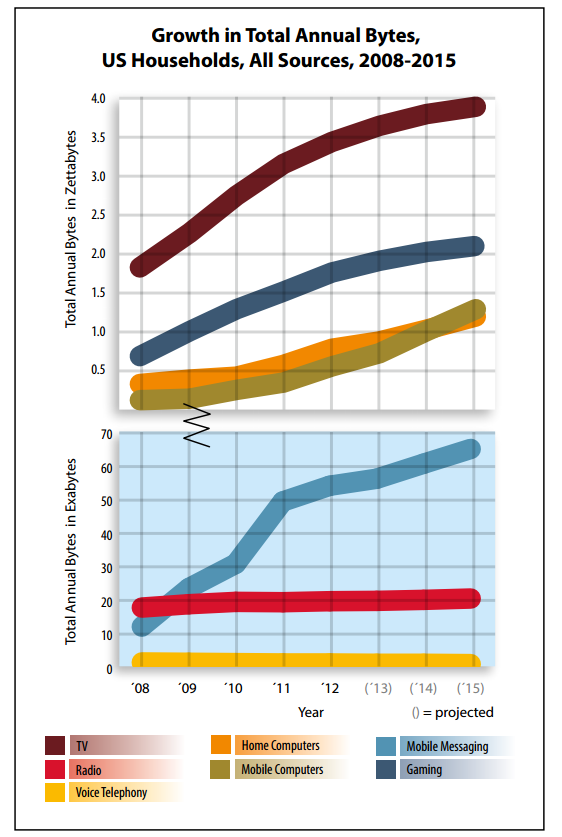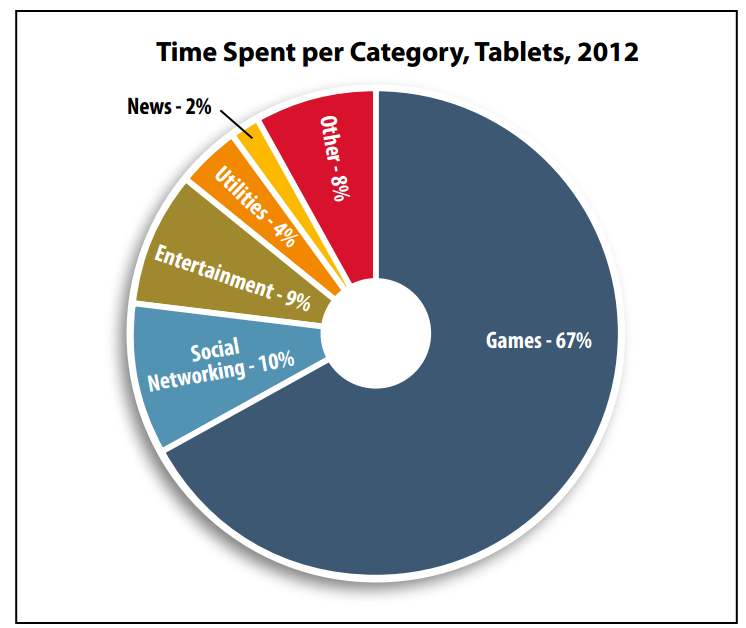Americans’ media consumption to soar in 2015
Predicts by 2015, average media consumption will be 15.5 hours a day per person
November 4, 2013
[+] A total of 6.9 zettabytes of media flows to individuals and households in a year — that’s 6.9 million million gigabytes, or 1021 bytes.
A total of 6.9 zettabytes of media flows to individuals and households in a year — that’s 6.9 million million gigabytes, or 1021 bytes.
The report looks at media consumption by individuals in and out of the home, excluding the workplace, between 2008 and 2015, breaking “media” down into 30 categories of media type and delivery (e.g. television, social media, computer gaming).
Information reported in the study was canvassed from several hundred data sources, including media measurement firms such as Neilsen, Arbitron, ComScore, investor and analyst firms, government sources and foundation and research publications.
Growth From 2008-2012
 2015: What’s Ahead
2015: What’s Ahead
[+] Looking
across different sources of media — from traditional media (TV, radio,
voice calls) to new digital sources (tablet computers, mobile gaming
devices, smartphones, mobile video) — the report makes a surprising
discovery.
Looking
across different sources of media — from traditional media (TV, radio,
voice calls) to new digital sources (tablet computers, mobile gaming
devices, smartphones, mobile video) — the report makes a surprising
discovery.
“Despite the popular belief that the ubiquitous computer and smartphone dominate modern media life, traditional media, including TV, radio and voice calls, still account for two-thirds of total U.S. household media time,” Short concluded.
“Of course the picture is a changing one as digital platforms continue to grow, but they are still only a third of total annual media time.”
New digital sources, however, are having major effects on most forms of media consumption. If we change our focus from the time people spend viewing media to the number of bytes presented, over half of all bytes are now received by computers, with mobile computers the most rapidly growing segment.
The report also includes data on Americans’ use of media dating back to the 1960s. Over those decades, the supply of digital media measured in bytes has been growing at compounded rates ranging between 6 and 30 percent each year. Media consumption, on the other hand — what we actually pay attention to — has been growing at compounded rates ranging between 3 and 5 percent each year.
The “How Much Media?” research program was sponsored by an industry consortium including Alcatel-Lucent, AT&T, Cisco Systems, Hewlett Packard, PricewaterhouseCoopers, Seagate Technology and Verizon Wireless. Lucy Hood, president and chief operations officer of the Academy of Television Arts and Sciences, and Josette Bonte, CTM chief strategy officer and director of research, contributed industry guidance and program support.
James E. Short is a Visiting Researcher with the Institute for Communication Technology Management at the USC Marshall School of Business. He is lead scientist for the Center for Large-Scale Data Systems Research (CLDS) at the San Diego Supercomputer Center, UC San Diego.
 A total of 6.9 zettabytes of media flows to individuals and households in a year — that’s 6.9 million million gigabytes, or 1021 bytes.
A total of 6.9 zettabytes of media flows to individuals and households in a year — that’s 6.9 million million gigabytes, or 1021 bytes.A Look into the Evolution of Storage Devices [1956-2013]
That’s according to “How Much Media? 2013 Report on American Consumers,” produced by the Institute for Communications Technology Management (CTM) at the USC Marshall School of Business and CTM Visiting Researcher James E. Short.The report looks at media consumption by individuals in and out of the home, excluding the workplace, between 2008 and 2015, breaking “media” down into 30 categories of media type and delivery (e.g. television, social media, computer gaming).
Information reported in the study was canvassed from several hundred data sources, including media measurement firms such as Neilsen, Arbitron, ComScore, investor and analyst firms, government sources and foundation and research publications.
Growth From 2008-2012
- U.S. media consumption totaled 3.5 zettabytes, an average of 33 gigabytes per consumer per day (One byte is one character of text. A gigabyte is 109 bytes. A zettabyte is 1021 bytes.). By 2012, total U.S. consumption had increased to 6.9 zettabytes, an average of 63 gigabytes per person per day.Put another way, researcher Short said, if we printed 6.9 zettabytes of text in books, and stacked those books as tightly as possible across the United States, including Alaska and Hawaii, the pile would be almost 14 feet high.
- In 2008, Americans talked, viewed and listened to media for 1.3 trillion hours, an average of 11 hours per person per day. By 2012, total consumption had increased to 1.46 trillion hours, an average of 13.6 hours per person per day, representing a year over year growth rate of 5%.
 2015: What’s Ahead
2015: What’s Ahead- By 2015, the data indicate that Americans will consume media for more than 1.7 trillion hours, an average of approximately 15.5 hours per person per day. The amount of media delivered will exceed 8.75 zettabytes annually, or 74 gigabytes — 9 DVDs worth — of data sent to the average consumer on an average day.
- Mobile messaging hours, which in 2012 accounted for approximately 9% of voice call hours, will double to over 18% of voice hours, a year over year growth rate of more than 27%.
- Viewing video on the Internet averaged less than 3 hours a month in 2008; by 2012, viewing time increased to almost 6 hours a month, a year over year growth rate of 21%. By 2015, the report projects that Americans will be watching video for almost 11 hours a month, a compound annual growth rate of 24% a year.
- From 2008 to 2015, total annual hours for users of Facebook and YouTube will grow from 6.3 billion hours to 35.2 billion hours, a year over year growth rate of 28%.
[+]
 Looking
across different sources of media — from traditional media (TV, radio,
voice calls) to new digital sources (tablet computers, mobile gaming
devices, smartphones, mobile video) — the report makes a surprising
discovery.
Looking
across different sources of media — from traditional media (TV, radio,
voice calls) to new digital sources (tablet computers, mobile gaming
devices, smartphones, mobile video) — the report makes a surprising
discovery.“Despite the popular belief that the ubiquitous computer and smartphone dominate modern media life, traditional media, including TV, radio and voice calls, still account for two-thirds of total U.S. household media time,” Short concluded.
“Of course the picture is a changing one as digital platforms continue to grow, but they are still only a third of total annual media time.”
New digital sources, however, are having major effects on most forms of media consumption. If we change our focus from the time people spend viewing media to the number of bytes presented, over half of all bytes are now received by computers, with mobile computers the most rapidly growing segment.
The report also includes data on Americans’ use of media dating back to the 1960s. Over those decades, the supply of digital media measured in bytes has been growing at compounded rates ranging between 6 and 30 percent each year. Media consumption, on the other hand — what we actually pay attention to — has been growing at compounded rates ranging between 3 and 5 percent each year.
The “How Much Media?” research program was sponsored by an industry consortium including Alcatel-Lucent, AT&T, Cisco Systems, Hewlett Packard, PricewaterhouseCoopers, Seagate Technology and Verizon Wireless. Lucy Hood, president and chief operations officer of the Academy of Television Arts and Sciences, and Josette Bonte, CTM chief strategy officer and director of research, contributed industry guidance and program support.
James E. Short is a Visiting Researcher with the Institute for Communication Technology Management at the USC Marshall School of Business. He is lead scientist for the Center for Large-Scale Data Systems Research (CLDS) at the San Diego Supercomputer Center, UC San Diego.
(¯`*• Global Source and/or more resources at http://goo.gl/zvSV7 │ www.Future-Observatory.blogspot.com and on LinkeIn Group's "Becoming Aware of the Futures" at http://goo.gl/8qKBbK │ @SciCzar │ Point of Contact: www.linkedin.com/in/AndresAgostini
 Washington
Washington